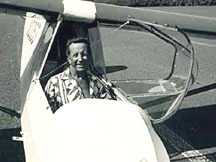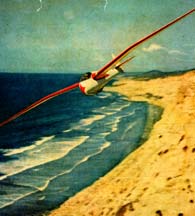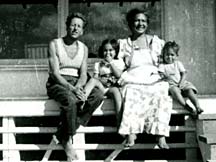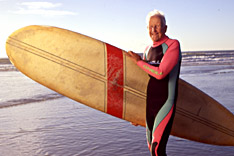The Life of Woody Brown Synopsis:
 This hour-long television documentary profiles an extraordinary 95-year-old free spirit named Woody Brown. A surfing, sailing and soaring legend, Woody has lived a life rich in both adventure and accomplishment. Inventor, record-setting pilot, and pioneer big wave surfer, Woody has achieved all his accomplishments with a singular sense of joy and with remarkable selflessness. Like a modern Thoreau on a surfboard, Woody has embraced the spiritual connection to nature that sustains traditional Hawaiian culture.
This hour-long television documentary profiles an extraordinary 95-year-old free spirit named Woody Brown. A surfing, sailing and soaring legend, Woody has lived a life rich in both adventure and accomplishment. Inventor, record-setting pilot, and pioneer big wave surfer, Woody has achieved all his accomplishments with a singular sense of joy and with remarkable selflessness. Like a modern Thoreau on a surfboard, Woody has embraced the spiritual connection to nature that sustains traditional Hawaiian culture.
Along with Woody’s triumphs however, there have been tragedies, including the devastating loss of his wife during childbirth and his painful decision to leave his infant son and eight-year-old daughter with relatives. It was in the midst of this grief that Woody first came to Hawai’i, where his discovery of profound connections with the ocean and the magnificent land of the islands transformed his life. Some sixty years later, Woody’s reunion and reconciliation with his son and daughter, which was captured on video, was a powerful and redeeming experience for all three of them.
Of Wind and Waves explores Woody’s life in his own words and from the perspectives of those who have shared his journey. There is also a rich archive of film and photography from every stage of Woody’s life to complement coverage of his contemporary life. Of Wind and Waves also portrays the land, people and culture of Hawai’i over the six-and-a-half-decade span of Woody’s life there.
Film Description
The program opens with a scene of Woody arriving at a Santa Cruz surf shop to sign DVDs, posters and photos for adoring fans. Woody’s granddaughter recounts how Woody has always attracted a crowd of loving fans. We then see Woody, his daughter, granddaughter and great-granddaughter looking through Woody’s life photo album, a scene that reveals Woody’s self-deprecating humor and facilitates looking back to his childhood.

Archival footage takes the viewer to the privileged world that Woody grew up in as an eastern blueblood: Wall Street in the Roaring ’20s; a summer home in the Hamptons; early aviation footage. Woodbridge Parker Brown was born with a silver spoon in his mouth. Woody’s father owned a lucrative brokerage; the family was listed in the Social Register and his relatives were charter members of The 400 – the roster of America’s most prominent and powerful families.But privilege, wealth, and prestige never appealed to Woody. He preferred to wander in the woods and on the beaches near the family’s retreat in Rye, New York. It was there that his love of nature was born, and it was from there that he ran away at sixteen in pursuit of his dream of learning to fly.
Woody virtually lived at New York’s Curtiss Field where he became a protégé of Charles Lindbergh, helping prepare the Spirit of St. Louis for Lindy’s historic flight. Archival aviation footage shows Lindbergh training at Curtiss and also an early glider with Woody at the controls. Gliders became Woody’s passion. Soaring silently on invisible currents of air, he acquired the sensitivity one needs to read the air and wind and to stay aloft through a combination of will and skill.

Woody fell in love with an English beauty, Elizabeth Sellon (known as Betty), who shared his love of adventure and his disdain for the trappings of society. In 1935, they spent their honeymoon driving across the country to start a new life near San Diego. Archival stills show their car with a glider in tow. In La Jolla, Woody became a pioneer in the sport of surfing. He designed and built his own boards, recalls Don Okay, another surf pioneer and long-time friend. Woody also became the driving force behind the design and building of Torrey Pines Flight Park, still in operation today, as shown in both archival and contemporary footage.
In 1939, Woody set world soaring records for time aloft, altitude and distance. Archival footage shows his record-breaking flight and its press coverage which made Woody an instant national hero. But the wildly enthusiastic crowds that attended a parade in his honor in Wichita Falls, Texas frightened him. Then, as now, he had no interest in fame. He hurried home to La Jolla where Betty was ready to deliver their first child.

Betty died giving birth to their baby boy. Woody was shattered. He recalls his nearly suicidal depression that drove him to leave his newborn son, Jeffrey, and step-daughter, Jenny, with Betty’s family, turn his back on all his worldly possessions, and flee to the South Pacific. Archival and contemporary images combine to evoke the plunge from the heights of public acclaim and marital bliss to Woody’s private desolation.
When Woody arrived in Hawai’i in 1940, Honolulu was still a small town and most of Oahu was rural and unspoiled. Early recordings of slack key guitar and other traditional Hawaiian music evoke this era. Over archival footage of Hawai’i’s natural beauty — rainforest, seascapes, small farms and mountains–Woody recalls his early wanderings around the island. First hitchhiking, then riding an old bicycle, he fell in love with the island and with the native people who took him in. They shared with him their food and culture and a reverence for the earth and sea that Woody had instinctively embraced since childhood but had never before encountered. Woody soon realized that he had found his true home. The spirit of aloha, the belief in a love that links humans and nature and connects people with each other as “children of the land,” had saved him.
 Archival footage shows Hawai’i’s first big-wave surfers. As Woody renewed his interest in surfing, he became friends with island residents who were pushing the sport to new heights. Men like Wally Froiseth, John Kelly and Rabbit Kekai, a native Hawaiian, were among the first in the world to brave the mountainous waves of the Hawaiian surf. Because of Woody’s fearless enthusiasm, they accepted him as a member of their elite group and took him on “surfing safaris” to Makaha and to Castles where Woody first experienced 25-foot breakers. Wally, John and Rabbit recall Woody’s big-wave initiation. Woody remembers the exhilaration and terror he felt.
Archival footage shows Hawai’i’s first big-wave surfers. As Woody renewed his interest in surfing, he became friends with island residents who were pushing the sport to new heights. Men like Wally Froiseth, John Kelly and Rabbit Kekai, a native Hawaiian, were among the first in the world to brave the mountainous waves of the Hawaiian surf. Because of Woody’s fearless enthusiasm, they accepted him as a member of their elite group and took him on “surfing safaris” to Makaha and to Castles where Woody first experienced 25-foot breakers. Wally, John and Rabbit recall Woody’s big-wave initiation. Woody remembers the exhilaration and terror he felt.
Newsreel footage of the Japanese attack on Pearl Harbor shatters this mood. December 7, 1941 transformed Woody’s life in a different way than it did most others in Hawai’i and America. He became a conscientious objector. This status was not only unpopular; in the home of Pearl Harbor, it was dangerous. As Woody recalls, C.O.’s were harassed and often beaten in Hawai’i.
During the war, Woody worked for the Army as a surveyor in the South Pacific. It was on Christmas Island that Woody first saw a Polynesian double-hulled canoe. Extrapolating from the native design, Woody built the first modern catamaran. His boat, the Manu Kai, quickly became the fastest sailboat in the world. Woody, Rabbit Kekai, Hobie Alter, and Woody’s son, William (from a second marriage), recall the first catamarans in Hawai’i. Archival footage shows Polynesian outriggers and double-hulled canoes and the building and launch of Woody’s catamarans.
After the war, as more and more tourists came to the islands, Woody supported himself by giving thrill rides on his new boats off Waikiki Beach. Archival footage shows how fast and exciting those rides were. Soon Woody was commissioned to build boats, including a 100-foot model for industrialist Henry Kaiser. After Woody allowed Hobie Alter to market his revolutionary design, Alter patented the design and earned a fortune selling “Hobie Cats” all over the world. Woody never made a penny, but as he explains convincingly, he never cared about money.

Archival footage of a beautiful native hula dancer introduces Rachel Brown, known as the queen of the Honolulu hula scene. She and Woody fell in love and married. Home movies and stills of Woody, Rachel and their children combine with footage of a reunion of Woody and Rachel with their “hula friends.” Their apartment, located above a tavern called the Waikiki Surf Club, became a haven for dancers, surfers and anyone else who needed a meal or a place to stay. The film captures the Honolulu beach scene of those years as it retained the aloha spirit of true Hawaiian culture.
During the ’50s, ‘60s and ‘70s, Woody continued his carefree life of surfing and sailing, including a wild adventure recalled by Wally Froiseth when Woody skippered the first Pacific crossing in a catamaran and encountered 50-foot swells that nearly swamped the boat. We see Woody sailing his catamarans in archival and contemporary footage, with sound bites from former crew members. With multi-camera coverage, we re-create the moment in 1971 when Woody, then 59, took a glider to a Hawai’ian altitude record of 12,675 feet. Sadly, that achievement, like his previous soaring records on the mainland, was quickly followed by another tragic loss when Woody lost his beloved Rachel.

Once again, in tragedy Woody found a kind of salvation. Just as his loss of Betty had led him to Hawai’i, losing Rachel brought him to a spiritual awakening. He came to believe in a greater power and to dedicate the rest of his life to giving as much as he could through service to others. Woody’s philosophy of selfless love and service appears in action at the Hale Makua Adult Day Health Center where he volunteers. Watching his interactions with clients and staff, we hear Woody’s reflections on what service and the Center mean to him.
At age 79, Woody married Macrene Canaveral and fathered Woody Jr., known as JR. We see glimpses of Woody’s new family and touching scenes of Woody surfing with 7-year old JR, and at JR’s canoe rowing practice when he was 17.

The spirituality that informed Woody’s life after he lost Rachel led to considerable reflection, including self-criticism. Woody wondered if following his bliss exacted too high a cost on his family, including the son, Jeffrey, he abandoned when he fled to Hawai’i. Sixty-three years after that fateful decision, we witness the dramatic and poignant reunion between father and both abandoned children. In 2002, for the first time, Woody’s entire family came together– Jeffrey, his two daughters and their families and Woody’s youngest son, William. Mary Sue, Woody’s daughter with Rachel, who inherited her mother’s native Hawai’ian beauty, was instrumental in bringing the fractured family together. In candid conversations, Woody reflects on the life-choices

he has made, and explores the regret and guilt that have accompanied them. At the same time, he discovers that his judgments of himself are harsher than those of others. Jeffrey insists that forgiveness is not required, and that he understands how his father could have made such a choice. The reunion sequence powerfully communicates an intimate family experience of joy, reconciliation, healing and forgiveness.
Woody at 90 is seen riding the waves off Maui. A closing montage features Woody soaring, sailing and surfing in his beloved wind and waves, with voice-over testimonials from family and friends and, of course, Woody’s own inimitable words.
Of Wind and Waves premiered to rave reviews and great enthusiasm on a four-island, six venue tour of Hawaii in August, 2006. Click here for some of the press coverage. The documentary had its world premiere at Mountainfilm in Telluride over Memorial Day weekend, 2006, where it won “The Inspiration Award!” Woody’s daughter, Mary Sue Gannon, and son, Jeffrey Sellon were in Telluride to share the experience and celebration. In 2004, the 35-minute version won the “Audience Award for Best Short” at the Maui Film Festival. It received its Hawai’i broadcast premiere on PBS Hawaii on December 11, 2007 at 8:00 p.m., and national PBS broadcasts in March of 2008.
Producer/ Director/ Co-WriterDavid L. Brown
is an award-winning San Francisco documentary filmmaker who – since 1971 — has produced, written and directed over 80 productions and 10 documentaries on social, nuclear, health, environmental, peace and technology issues. His documentaries have received over 80 international awards and have been broadcast on PBS and in 16 countries. See BIO.
Editor/Videographer
 Steven Baigel is a documentary filmmaker and photographer who has worked with David L. Brown for over 20 years, first collaborating as co-producers of the Disarmament Film Festival held in Berkeley, California in 1983. Steven was a cameraman, sound recordist and editor on David’s 1985 anti-nuclear documentary film A QUESTION OF POWER and has since worked as an editor and cameraman on numerous documentary film projects of David’s including AMAZING, BOUND BY THE WIND, SURFING FOR LIFE, SENIORS FOR PEACE, THE BRIDGE SO FAR, DIGITAL DEMOCRACY COMES OF AGE and KEEPER OF THE BEAT.
Steven Baigel is a documentary filmmaker and photographer who has worked with David L. Brown for over 20 years, first collaborating as co-producers of the Disarmament Film Festival held in Berkeley, California in 1983. Steven was a cameraman, sound recordist and editor on David’s 1985 anti-nuclear documentary film A QUESTION OF POWER and has since worked as an editor and cameraman on numerous documentary film projects of David’s including AMAZING, BOUND BY THE WIND, SURFING FOR LIFE, SENIORS FOR PEACE, THE BRIDGE SO FAR, DIGITAL DEMOCRACY COMES OF AGE and KEEPER OF THE BEAT.
His other documentary credits as producer, director, editor, cameraman or sound recordist include films on such varied subject matter as Tibetan culture and Tibetan exiles, Western classical music, Indian classical music, domestic and international environmental issues, peace, nuclear disarmament, weapons in space, progressive political movements and political activism. Steven has photographed in India, Nepal, Tibet, Indonesia, Thailand, Africa, the Mid-East and Europe, among other locations around the world. His website is www.stevenbaigel.com.
Videographer
Judy Irving is an Emmy Award-winning filmmaker whose recent documentary, THE WILD PARROTS OF TELEGRAPH HILL, profiling Mark Bittner, a Bohemian Saint Francis, and his magical relationship with a flock of wild parrots in San Francisco, has been a phenomenal international success. Over a 35 year career, Judy has produced, directed and shot over 20 other documentaries in many countries. She co-produced and co-directed DARK CIRCLE, a harrowing journey through the nuclear age which premiered at the New York Film Festival’s Lincoln Center, won the national Emmy Award for “Outstanding Individual Achievement in News and Documentary,” a Special Merit Award at the Academy Awards Documentary Committee, and the Grand Prize at the Sundance Film Festival. They include: NAGASAKI JOURNEY, SECRETS OF THE BAY, TREASURES OF THE GREENBELT, QUIET REVOLUTION, KIDS BY THE BAY, SALT-POND HABITAT RESORATION AND NINETEEN ARRESTS, NO CONVICTIONS.
Videographer
Vicente Franco photographed and co-directed “Daughter from Danang” which was nominated for an 2002 Academy Award and an Emmy Award. It profiles a Vietnamese woman and her Amerasian daughter, who reunite in Danang after 22 years of separation. As a director of photography, Franco has shot many award-winning documentaries since 1980, including: NICARAGUA: FOR THE FIRST TIME (1985), about the 1984 Democratic Elections in Nicaragua; EL TEATRO CAMPESINO: THE FIRST TWENTY YEARS (1987) about the evolution of America’s first Chicano-Latino theater company, founded by Luis Valdez; CUBA VA: THE CHALLENGE OF THE NEXT GENERATION, a documentary about Cuban youth (1993); FREEDOM ON MY MIND (Academy Award Nomination 1994), about the Mississippi Voter Registration drive; MAKING PEACE: SOUL SURVIVORS (1996), about poet-writer ex-gang member Luis Rodriguez; THE FIGHT IN THE FIELDS (1996) About the history of the United Farm Workers and Cesar Chavez; IN SEARCH OF LAW AND ORDER (1997), about Juvenile delinquency and the justice system in the US; THE GOOD WAR, AND THOSE WHO REFUSED TO FIGHT IT (1999) About Conscientious Objectors in the Second World War.
Videographer/Sound
Randy Mills is a producer/ director/ videographer /editor on Maui. His recent credits include videographer for NBC’s TREASURE HUNTERS, videographer for the XTERRA TRIATHELON for Turner Broadcasting, videographer for Fox News, gaffer for the ICONOCLAST series on the Sundance Channel, and gaffer for the Golf Channel’s hit show, BIG BREAK V. For six years, he was Special Projects Coordinator and Producer/videographer/editor for Akaku: Maui Community Television.
Sound
Jaime Kibben, in memoriam: http://www.foodfirst.org/archive/media/news/2003/jaimekibben.html
Editor
Gina Leibrecht has been a director/ editor since 1990. In 1998, she began collaborating with the acclaimed documentary filmmaker, Les Blank, on several projects, including ALL IN THIS TEA, which she is co-producing, co-directing and editing. She also edited NATIVE GLORY under Blank’s direction, a film about the whimsical art collector, Rene di Rosa; and THE MAESTRO RIDES AGAIN for Blank’s DVD THE MAESTRO: KING OF THE COWBOY POETS. Gina edited Frank Green’s COUNTING SHEEP about the endangered Sierra Nevada bighorn sheep, which aired on KQED’s “Truly California” series and won a Northern California Emmy Award for Best Documentary in 2006; Gina edited Karina Epperlein’s PHOENIX DANCE about a dancer who returns to the stage after losing a leg to cancer, which won San Francisco International Film Festival’s Golden Gate Award for Best Documentary Short in 2006. In 2004 she directed and edited the short documentary, LITTLE BROTHERS, which aired on San Francisco’s KRON TV. She also edited Fawn Yacker’s UGLY DUCKLINGS; Larry Reed’s DVD series EXPLORATION OF THE SHADOW WORLD; and Kevin White’s A LAND BETWEEN RIVERS a one-hour documentary about the history of California’s Central Valley, which was broadcast throughout California.
Narrator
Steve Pezman was Editor of Surfer magazine for a decade and Publisher for twenty years. In 1991, as Editor/ Publisher, he founded The Surfer’s Journal, universally acknowledged as the best surfing publication targeting the over-40 surfer. The Surfer’s Journal featured a 9,000 word article on Woody Brown and published several dozen books and a video series on surfing history. Steve was on the founding advisory boards of the Surfrider Foundation, the Surf Industry Manufacturer’s Association and the Surfing Heritage Foundation.
Co-Writer
 Charlie Pearson has been an award-winning documentary script writer for 25 years and his work has appeared o n PBS, TBS, HBO, Showtime, Discovery, The Learning Channel, Disney an d the major networks. His recent credits include the DIGITAL DIVIDE (funded by ITVS), SURFING FOR LIFE, SAN FRANCISCO IN THE 20’s (for KRON, NBC affiliate), CHINATOWN (FOR KQED in S.F., aired on national PBS), WONDERS SACRED AND MYSTERIOUS (Reader’s Digest Video, aired on Disney), and GHOST OF THE ROCKIES for ABC.
Charlie Pearson has been an award-winning documentary script writer for 25 years and his work has appeared o n PBS, TBS, HBO, Showtime, Discovery, The Learning Channel, Disney an d the major networks. His recent credits include the DIGITAL DIVIDE (funded by ITVS), SURFING FOR LIFE, SAN FRANCISCO IN THE 20’s (for KRON, NBC affiliate), CHINATOWN (FOR KQED in S.F., aired on national PBS), WONDERS SACRED AND MYSTERIOUS (Reader’s Digest Video, aired on Disney), and GHOST OF THE ROCKIES for ABC.
FISCAL SPONSOR
Film Arts Foundation (FAF) in San Francisco is the project ’s non-profit fiscal sponsor. FAF will receive and adm inister all tax-deductible funding received. Their 501(c)(3) letter is available upon request. www.filmarts.org
DISTRIBUTION
OF WIND AND WAVES has been acquired for international television and home video distribution by WGBH Educational Foundation. It will also be self-distributed by David L. Brown Productions and to American surf shops by Surf Video Network. The program has been submitted to several of the top video distributors specializing in gerontology and elderly health and fitness issues. The chosen distributor would reach all educational and non-theatrical markets for videos on health, the elderly and healthy aging. The video will also be distributed by the producers to senior service agencies, to health educators and to most of the major surfing and sailing shops throughout the U.S. which market surfing and sailing videos. To promote video and DVD sales, the producers will solicit reviews and feature articles in many surfing, sailing, soaring, health education and gerontology publications
OF WIND AND WAVES will be entered into every major film and video festival which features documentaries, including Ocean and Mountain Film Festivals. The documentary has already screened in ten festivals and won two awards: the “Inspiration Award” at Mountainfilm in Telluride, and “Best Surf Film” at the Byron Bay Film Festival in Australia. The producer will also arrange for limited theatrical distribution in coastal areas, especially Hawai’i, California and Florida, where surfing and sailing are popular. The film, with Woody along, had a very successful four-island tour of Hawaii in August of 2006.
The national PBS broadcast will be provided by NETA (the National Educational Telecommunication Association) in March of 2008, with the program being presented by PBS Hawaii. The broadcasts will be publicized and promoted in major cities in cooperation with the senior service, sailing, soaring and surfing communities. Corporate underwriting will be solicited after we receive a PBS airdate.
The producers will arrange premiere screenings at several key conferences on aging such as the Conference of the American Society on Aging. They will attempt to promote and publicize Of Wind and Waves in every periodical and magazine which reviews videos on elderly health and fitness, on sailing or on surfing. This would include a major feature story in Surfer’s Journal, in Catamaranmagazine and in other surfing, sailing and soaring magazines.
